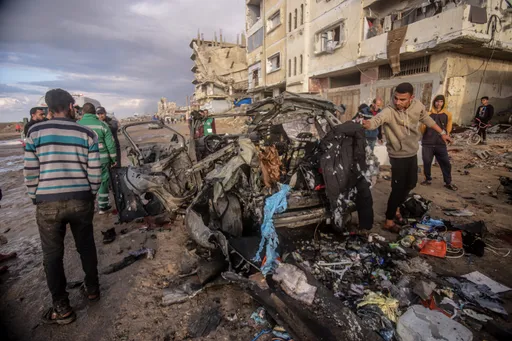A Russian anti-satellite missile launch has caused 1,500 pieces of “space junk” to enter the Earth’s orbit, which NASA has been calling the "world’s largest garbage dump.”
US officials slammed Moscow for launching the missile earlier this week that blew up a Russian satellite and created a mass of space debris that endangered the International Space Station's crew.
Anti-satellite missile strikes such as this contribute the most significant amount of trash to space, as thousands of pieces of debris are blasted into Earth’s orbit.
According to NASA, just two single events - the destruction of the Chinese Fengyun-1C spacecraft in 2007, and the accidental collision of an American and a Russian spacecraft in 2009 - increased the amount of orbital debris by 70 percent.
An estimated 190,000 kilograms of debris, including crashed probes, have even been left on the Moon.
But what is space junk exactly, and what can we do about it?
Dangerous debris
“Space junk” is defined as artificial objects left by humans in space and which no longer serve a useful purpose. “Space debris,” on the other hand, is a more general term referring to both meteoroids and orbital debris.
According to the European Space Agency, more than 9,300 tons of materials accumulated over 60 years of space activity are currently orbiting Earth.
Some of this junk is as large as dead satellites, and some is as small as paint flecks that have fallen off a rocket during launch.
According to Wired, this floating trash pile even includes bizarre objects such as a spatula.
The dangers lie in the build up of space junk. NASA scientist Donald Kessler warned of this back in 1978 when he said that the debris will continue to multiply as objects collide and create new pieces.
According to “the Kessler syndrome,” if this chain reaction continues, the Earth's orbit will become unusable.
READ MORE:Indian satellite destruction created debris, endangering ISS - NASA
Orbital junk yard
Most space junk surrounds the planet in what is called low earth orbit (LEO), an area between 160 kilometres and 1000 kilometres above earth.
Due to its proximity to earth, LEO is most commonly used for satellite imaging and is home to the International Space Station (ISS).
However, NASA describes LEO as “an orbital space junk yard” that presents one of the highest risks to the ISS from potential “catastrophic” collisions.
Currently in this "space junk yard" there are more than 4,550 operational satellites, and 3,000 dead ones.
Nowadays there are monitoring systems in place to prevent collisions.
The United States Department of Defense monitors more than 29,000 cataloged objects with a combination of optical and radar sensors known as the Space Surveillance Network (SSN).
About 24 percent of the catalogued objects in SSN are satellites, with less than a third of them operational, according to ESA.
To assist in monitoring and keeping the ISS crew safe, NASA launched the ISS Orbital Debris Collision Avoidance Process in 1979.
According to the plan, The Joint Space Operations Center (JSpOC) monitors debris based on radar tracking using the SSN, and screens the ISS trajectory multiple times per day.
READ MORE: Is outer space becoming the new wild west?
From paint fleck to bullet
However, the system can only detect objects larger than 5-10 centimetres in LEO and 30 centimetres to 1 metre at geostationary (GEO) altitudes.
Currently more than 36,500 objects in orbit are greater than 10 centimetres, one million are between 1-10 centimetres and 330 million are between 1-10 millimetres, according to ESA estimates.
The space junk moves at dangerous speeds with most reaching over 28,968 kilometres per hour, almost seven times faster than a bullet, says NASA.
Due to the high speed and amount of debris floating, even the smallest particles can “damage, degrade, or destroy spacecraft,” posing a serious threat to future space exploration and operations.
In fact, the first documented example of debris damage to a space shuttle was caused by a 0.2 millimetre paint fleck in 1983 that hit flight STS-7, creating a hole in the outer window panel.
Since 1961, more than 560 fragmentation events have occurred, with the majority due to explosions of spacecraft and rockets in the upper stages of launch.
Space sustainability
Space junk will remain in orbit unless it re-enters the Earth’s atmosphere, is broken down by the harsh space environment, or is removed manually.
Some objects in lower orbits can return after a few years and mostly burn-up before they ever reach the ground.
However, any space junk at altitudes higher than 36,000 kilometres “can continue to circle earth for hundreds or even thousands of years.”
By quickly removing satellites from orbit after their mission is complete, we can prevent the risk of collisions resulting in further space junk.
One way to remove these inactive satellites from orbit is by pulling them down into the Earth’s atmosphere, where they will burn up. To accomplish this, the ESA developed the “space claw,” known as ClearSpace-1, which will launch in 2025 and is designed to capture and dispose of space junk.
The removal process could also be done with magnets. Japan-based orbital debris removal company Astroscle has developed Elsa-D (End-of-Life Service demonstration), which consists of two spacecrafts that work together to latch onto and capture pieces of debris stuck in orbit.
With its successful demonstration of Elsa-D on August 25th, 2021, Astroscale is helping combat one of the major challenges of debris removal: docking with or capturing the object in orbit.
Another system of active debris removal (ADR) uses lasers to heat up the satellite and increase its atmospheric drag, or push debris out of the way.
Earlier this year, Australian company Electro Optic Systems (EOS), unveiled laser technology that will "nudge" the junk out of orbit.
However, most of these ADR removal processes are expensive and only useful for larger pieces of debris like defunct satellites.
In fact, there’s currently no way to clean up the tiny debris pieces, so we can only wait for them to naturally re-enter Earth's atmosphere. Therefore, the best way to combat the issue involves global preventative measures against debris build up.
Global cooperation
The leading technical authority on space debris is the Inter-Agency Space Debris Coordination Committee, of which NASA and the European Space Agency are a part.
IADC was formed in 1993 to study and reach a consensus on space debris. It includes cooperation from 11 countries and their space agencies: Russia, China, UK, Italy, France, Canada, Germany, India, Japan, Ukraine, and South Korea.
The IADC conducts campaigns to review debris research efforts. It also provides opportunities for member states to cooperate on clean-up efforts.
Meanwhile, scientists and global initiatives are trying to tackle space waste in other ways.
Space Waste Lab aims to up-cycle space junk by creating art installations such as “Shooting Stars,” 3D-printings of moon habitats, and a sun reflector to combat climate change.
However, Dimitar Sasselov, Professor of Astronomy at Harvard and co-investigator on NASA's Kepler mission, told TRT World he believes not enough effort is going towards clean up.
"It is expensive and it seems to me that until space debris becomes a much more serious obstacle, no government (or company) will spend the money," said Sasselov
Clean up practices are increasingly important as new space projects such as SpaceX and Amazon’s mega-constellations continue to clutter Earth’s orbit.
In order to preserve the cosmos for future generations of explorers, every country needs to start taking the issue of space junk more seriously.
READ MORE:Space junk problem alarms NASA
























